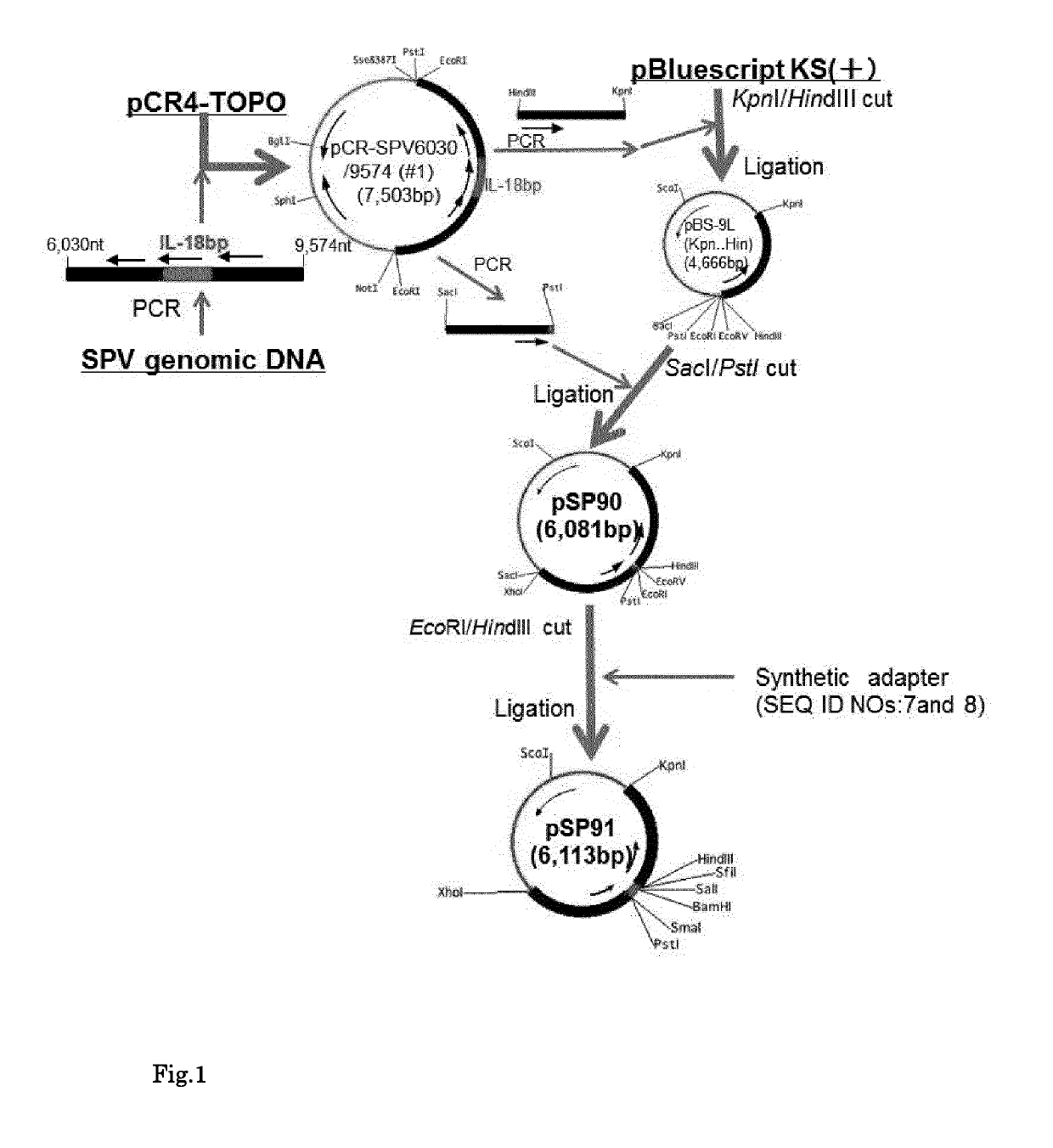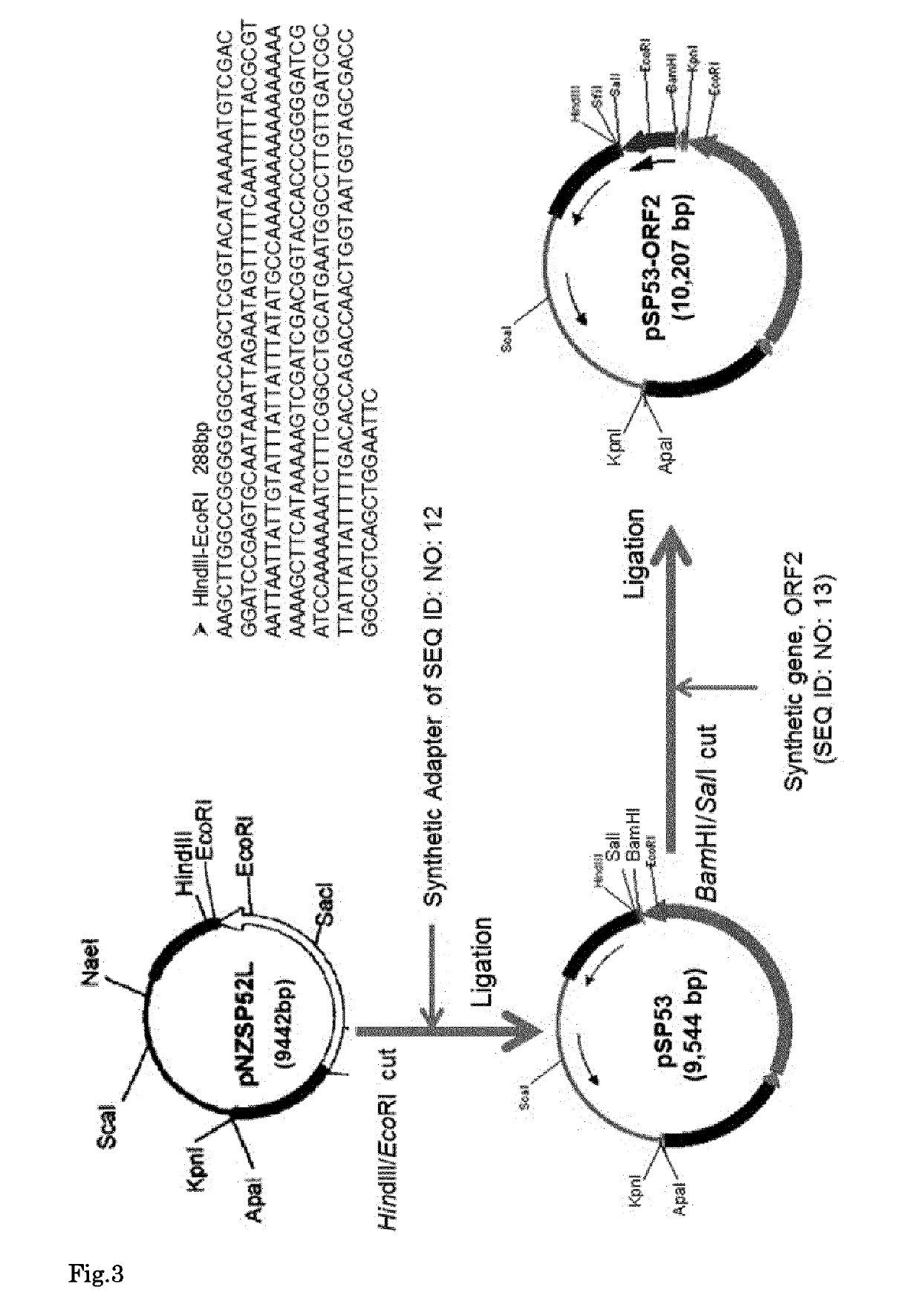Multivalent recombinant spv
a recombinant and recombinant technology, applied in the field of multivalent recombinant spv, can solve problems such as the elevation of expression levels
- Summary
- Abstract
- Description
- Claims
- Application Information
AI Technical Summary
Benefits of technology
Problems solved by technology
Method used
Image
Examples
example 1
Construction of Plasmids for Making Recombinant SPV
[0111](1) Constructing pSP91 (FIG. 1)
[0112]The SPV genomic DNA was prepared as follows:
[0113]SPV kasza strain (VR-363) and embryonic swine kidney cell, ESK-4 cells (CL-184) could be purchased from the American Type Culture Collection (ATCC). The ESK-4 cells were routinely cultured at 37.0 in 5% CO2 in Ham's F-12K medium (Gibco, Cat. No.: 21127-022) supplemented with 1% streptomycin-penicillin (Gibco, Cat. No.: 15140-122) and 5% FBS (Gibco, Cat. No.: 10437-028). For SPV genomic DNA preparation, confluent ESK-4 cells in a 225 cm2 flask were infected with SPV and incubated for 6 days until the cells were showing 100% cytopathic effect (CPE). The infected cells were then harvested by scraping the cells into the medium and centrifuging at 1300 rpm for 5 min. The medium was decanted, and the cell pellet was gently resuspended in 2 ml Phosphate Buffer Saline (PBS: 1.5 g Na2HPO4, 0.2 g KH2PO4, 0.8 g NaCl and 0.2 g KCl per litter H2O) and su...
example 2
Producing Recombinant Swinepox Viruses (rSPVs)
[0132](1) Producing rSPVs, SVR14 and SVR15 (FIG. 5)
[0133]Recombinant SPVs were generated in ESK-4 cells by homologous recombination between wild-type SPV genome and homology plasmid vectors. Sub-confluent ESK-4 cells in a 6-well plate were infected with wild-type SPV (wtSPV), and 17 hr later the wtSPV-infected cells were transfected with 2 μg of pSP911-Ess_ORF2cc or pSP911-ORF2cc using Lipofectamin Plus reagent (Invitrogen) and allowed to incubate at 37.0 for 5 days until cytopathic effect (CPE) had occurred. Cell lysates from infected-transfected cells were transfection seed (TFS) for SVR14 and TFS for SVR15, respectively. They were diluted into 1:20 with Ham's F-12K medium without FBS, and infected into ESK-4 cells in 96-well plates. Seven days later, each supernatant in 96-well plates were transferred to new blank 96-well plates, and infected cells were lysed with lysis buffer (20 mM Tris-Cl, 0.1M NaCl, 5 mM EDTA, 0.1% SDS, 200 μg / ml ...
example 3
In Vitro Analysis of Recombinant SPVs
[0140](1) Confirming Genome Structures and Stability Post Passages of SVR14 and SVR15 by PCR
[0141]To confirm genome structures of purified SVR14 and SVR15, their genomic DNAs were prepared as well as the procedures described in Example 1 (1), and used as no passage (+0p) templates for PCR. And to confirm genome stability of SVR14 and SVR15, they were passed to ESK-4 cells 15 times (+15p), and prepared as well as +0p. These genome DNAs were checked by PCR using a primer set of SP7450F and SP8552R shown in SEQ ID NOs: 22 and 23 (FIG. 6).
SEQ ID NO: 22CAATTGAAACATCTATATATCCTTSEQ ID NO: 23CAATGTGAAGCGATAAAATACAG
[0142]The results of PCR (FIG. 6) showed that purified SVR14 and SVR15 had expected genome structure and were wild-type SPV free, and that they were stable after 15 times in vitro passages.
[0143](2) Confirming PCV2-ORF2 Protein Expressed by SVR14 and SVR15
[0144]Molecular sizes of PCV2-ORF2 proteins expressed by SVR14 and SVR15 were analyzed by ...
PUM
| Property | Measurement | Unit |
|---|---|---|
| concentration | aaaaa | aaaaa |
| nucleic acid | aaaaa | aaaaa |
| genome structures | aaaaa | aaaaa |
Abstract
Description
Claims
Application Information
 Login to View More
Login to View More - R&D
- Intellectual Property
- Life Sciences
- Materials
- Tech Scout
- Unparalleled Data Quality
- Higher Quality Content
- 60% Fewer Hallucinations
Browse by: Latest US Patents, China's latest patents, Technical Efficacy Thesaurus, Application Domain, Technology Topic, Popular Technical Reports.
© 2025 PatSnap. All rights reserved.Legal|Privacy policy|Modern Slavery Act Transparency Statement|Sitemap|About US| Contact US: help@patsnap.com



